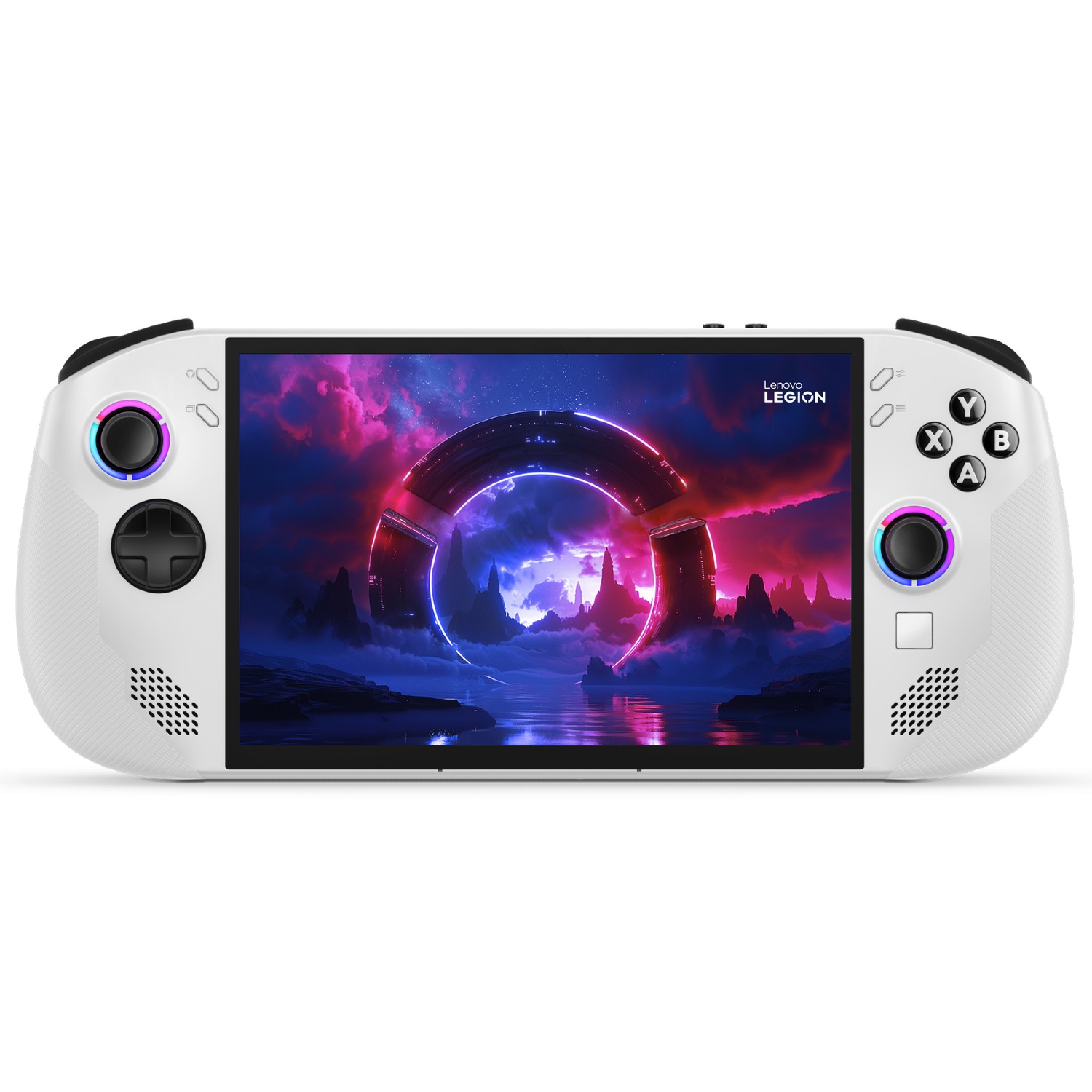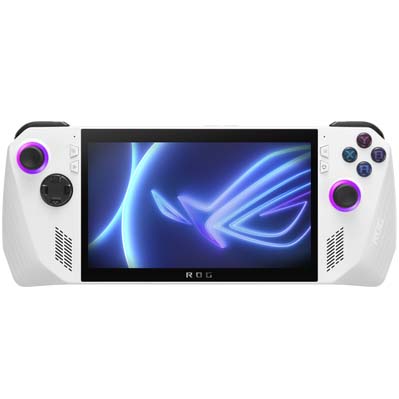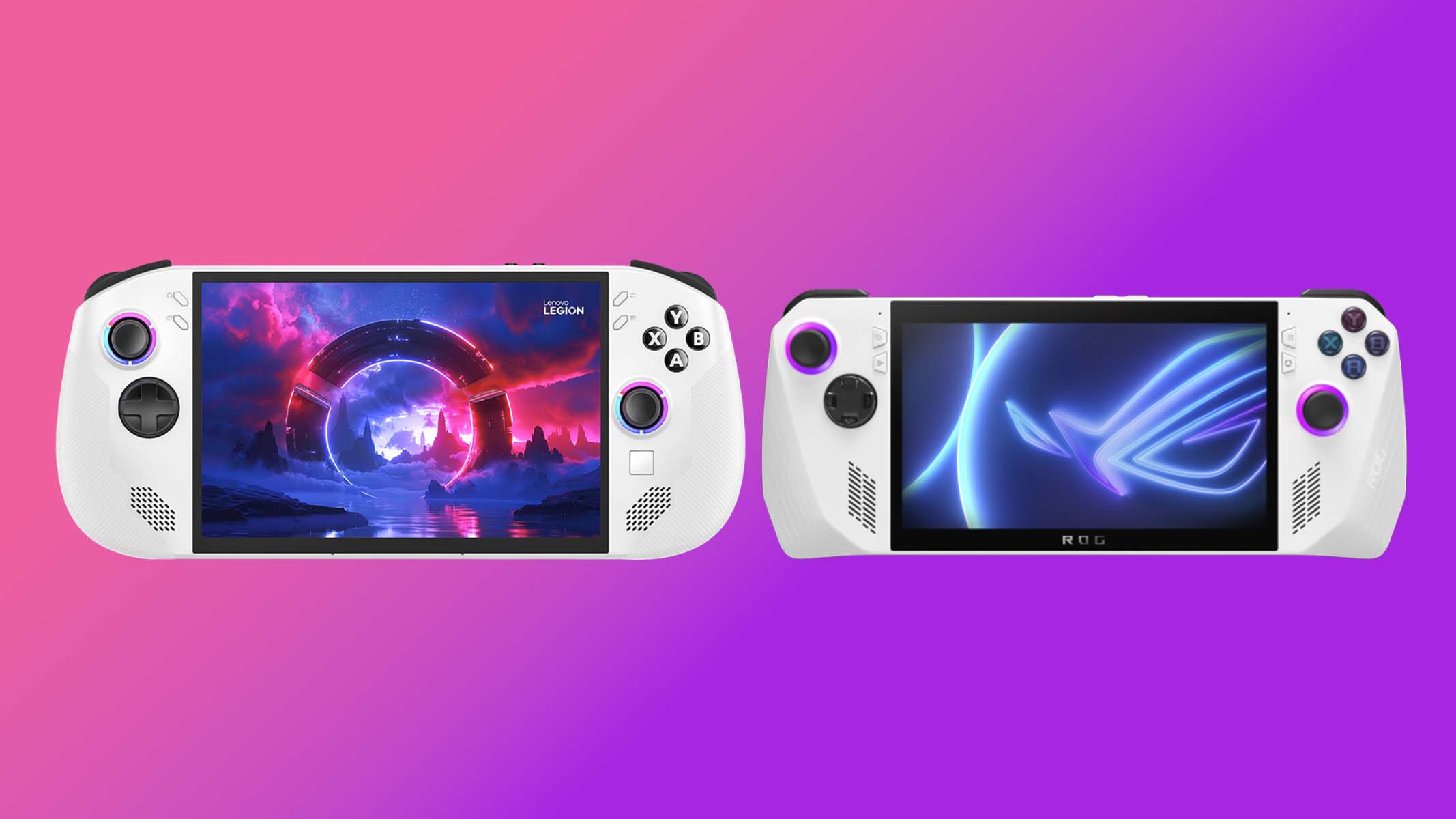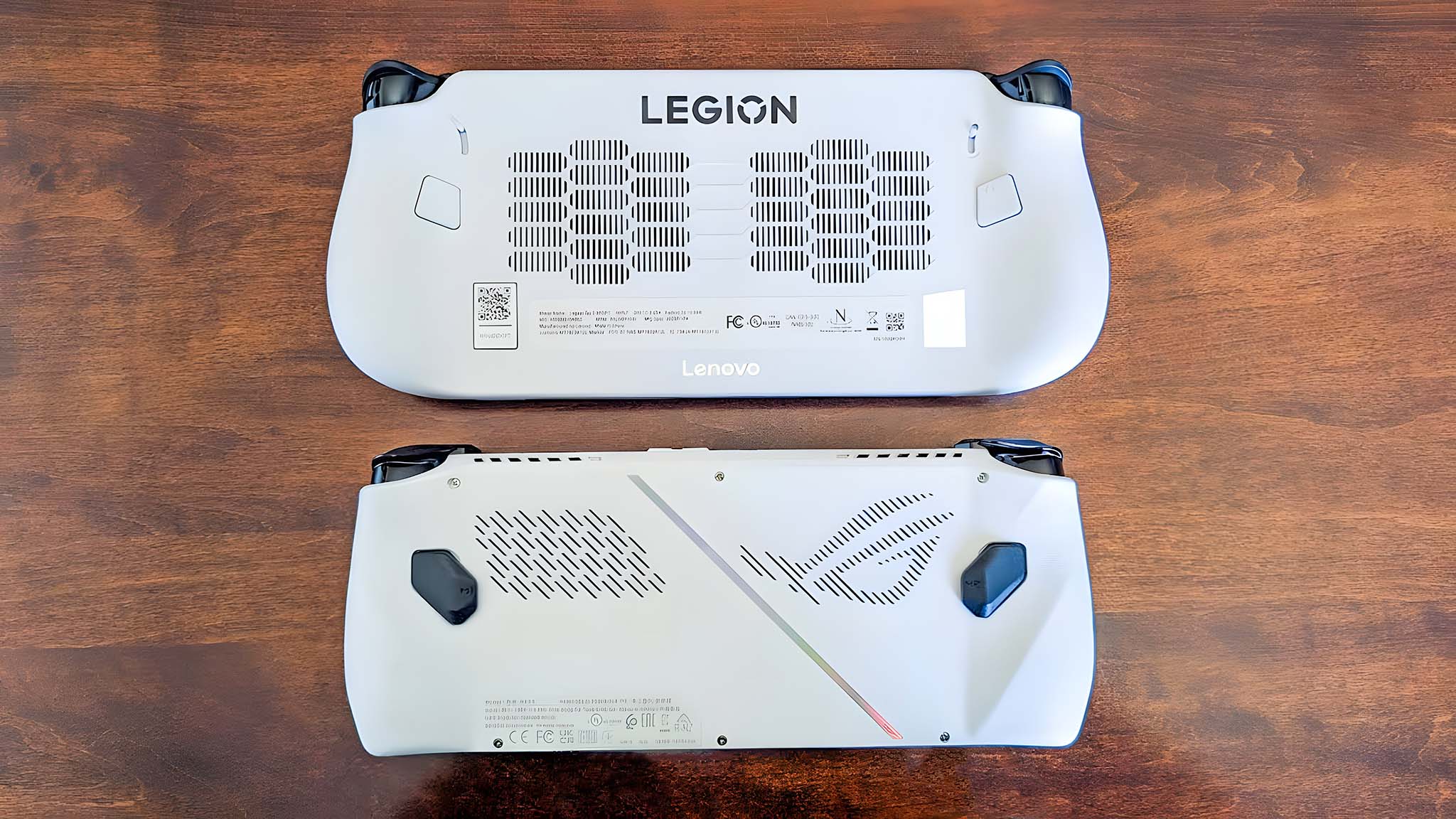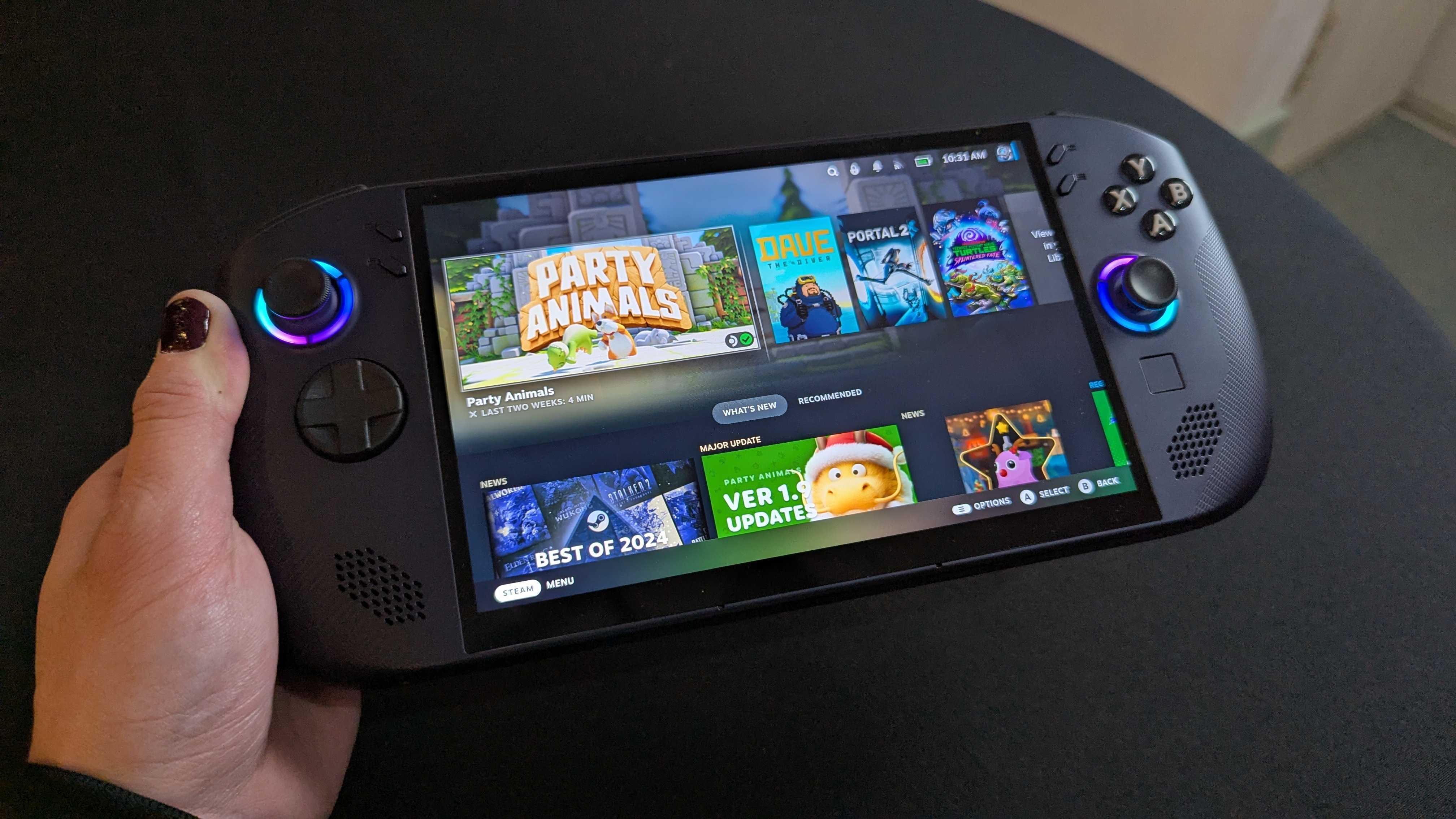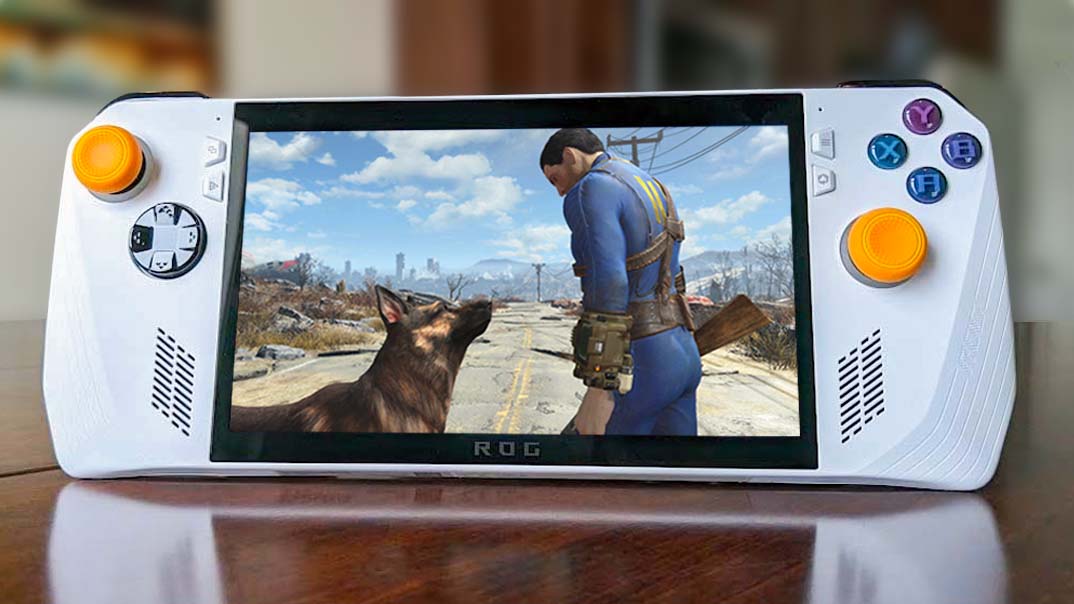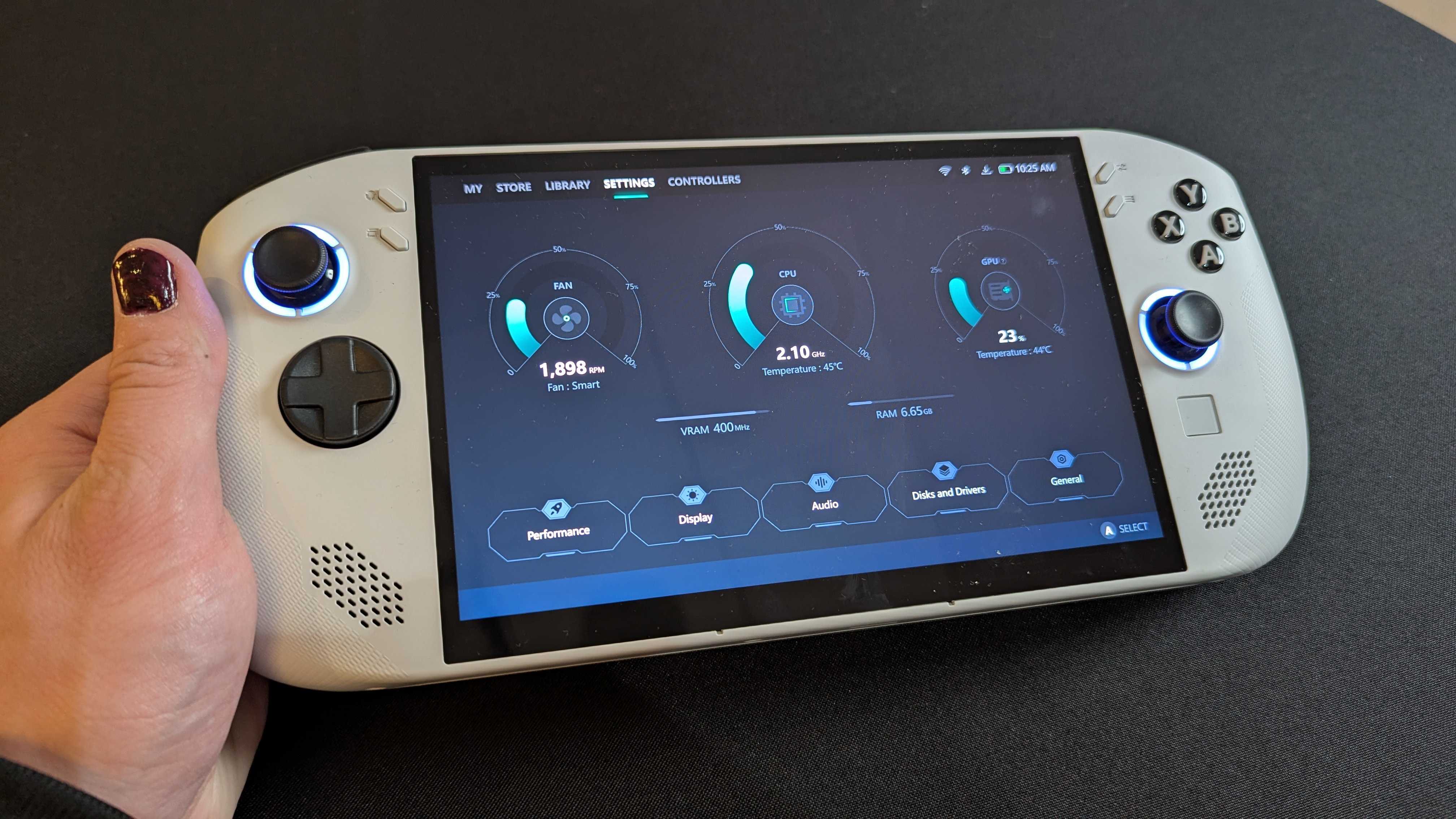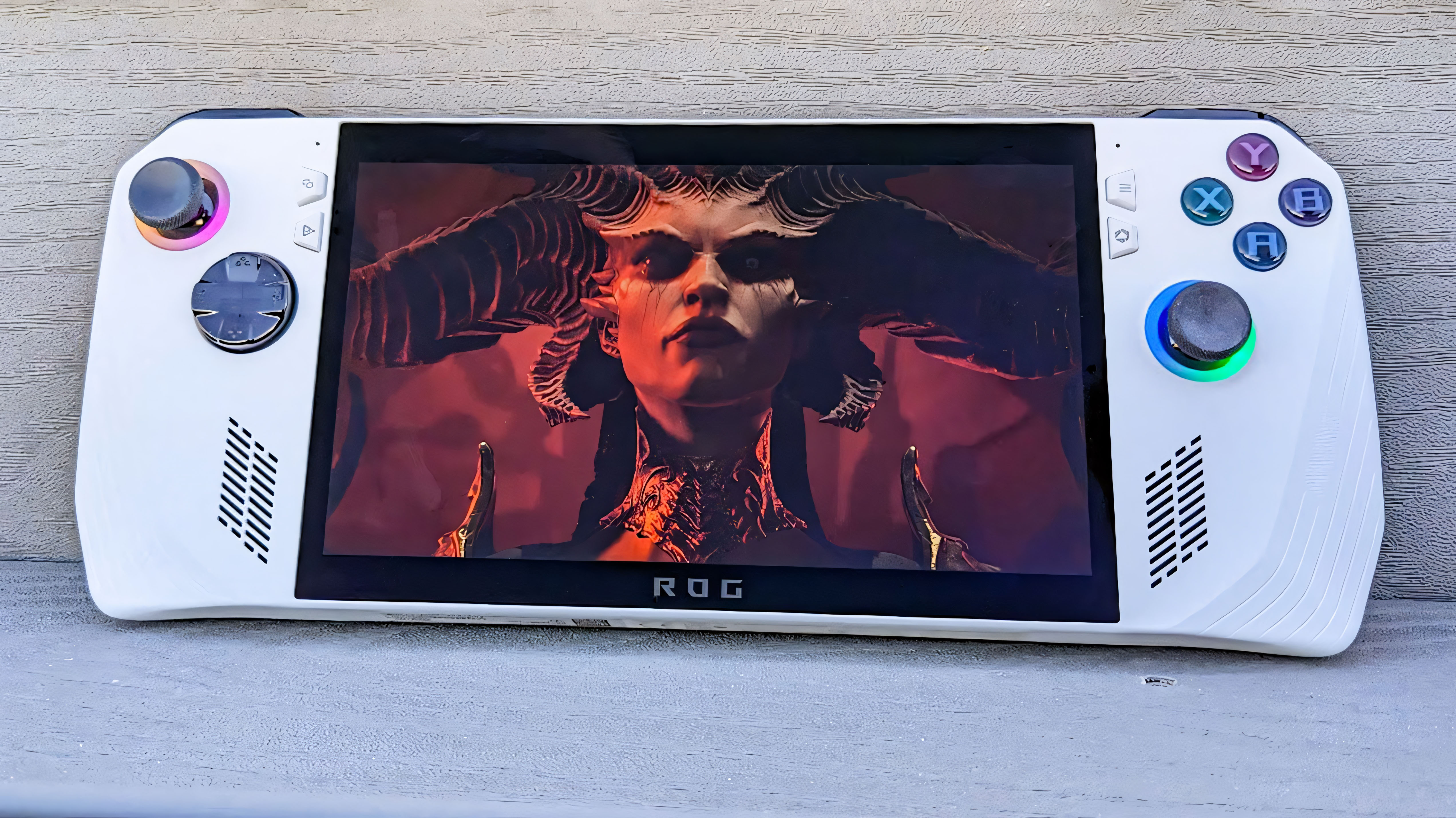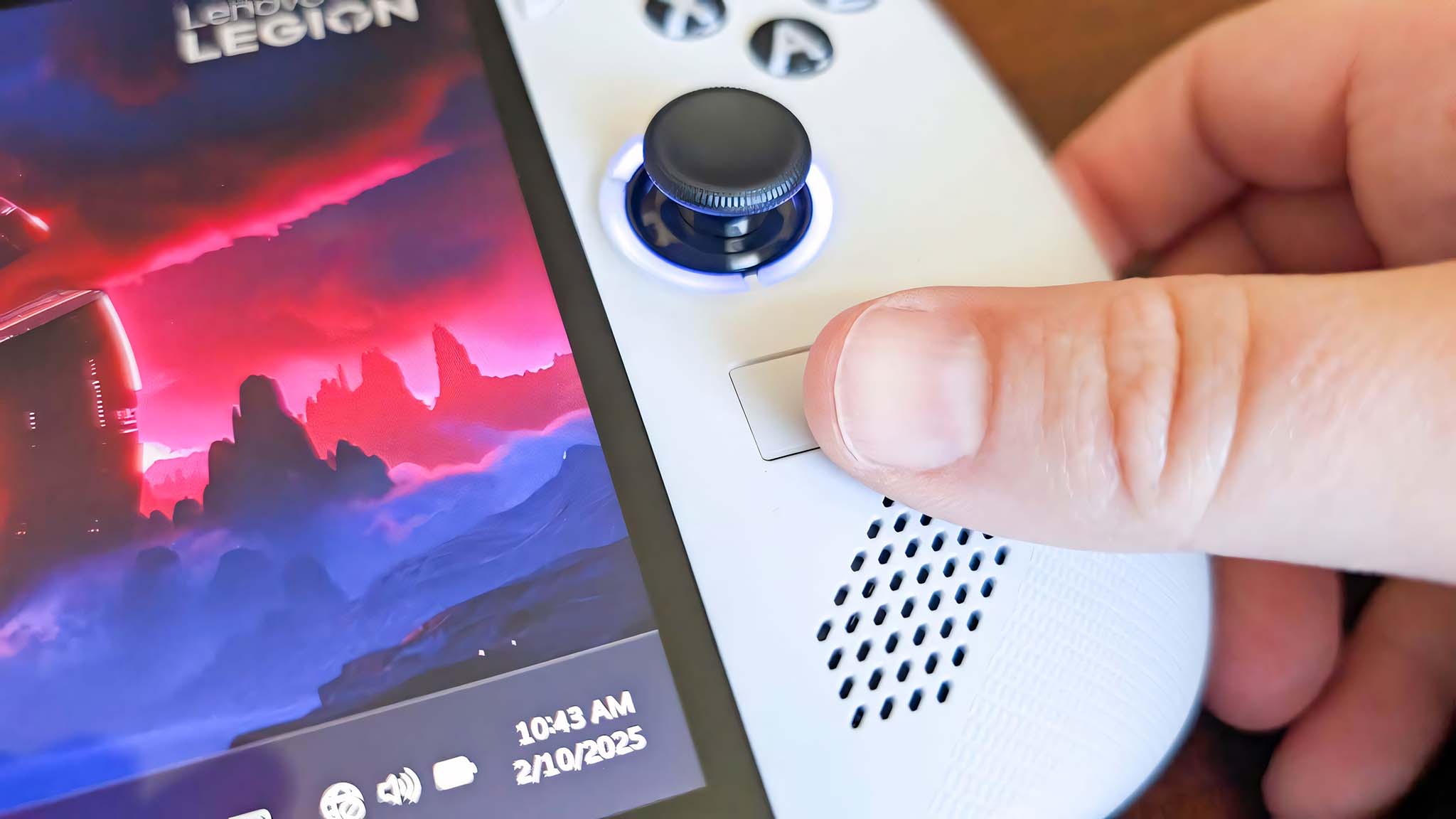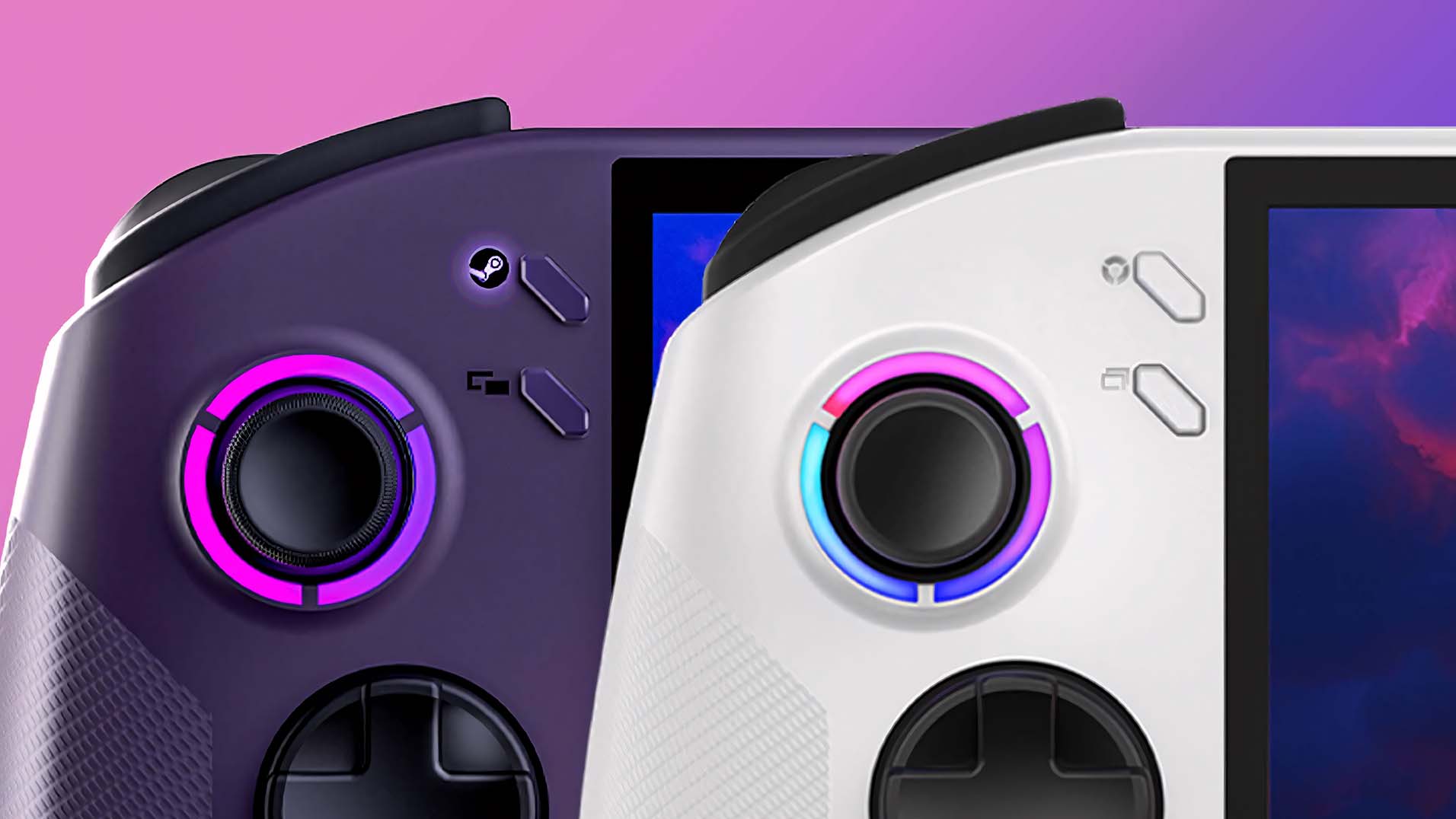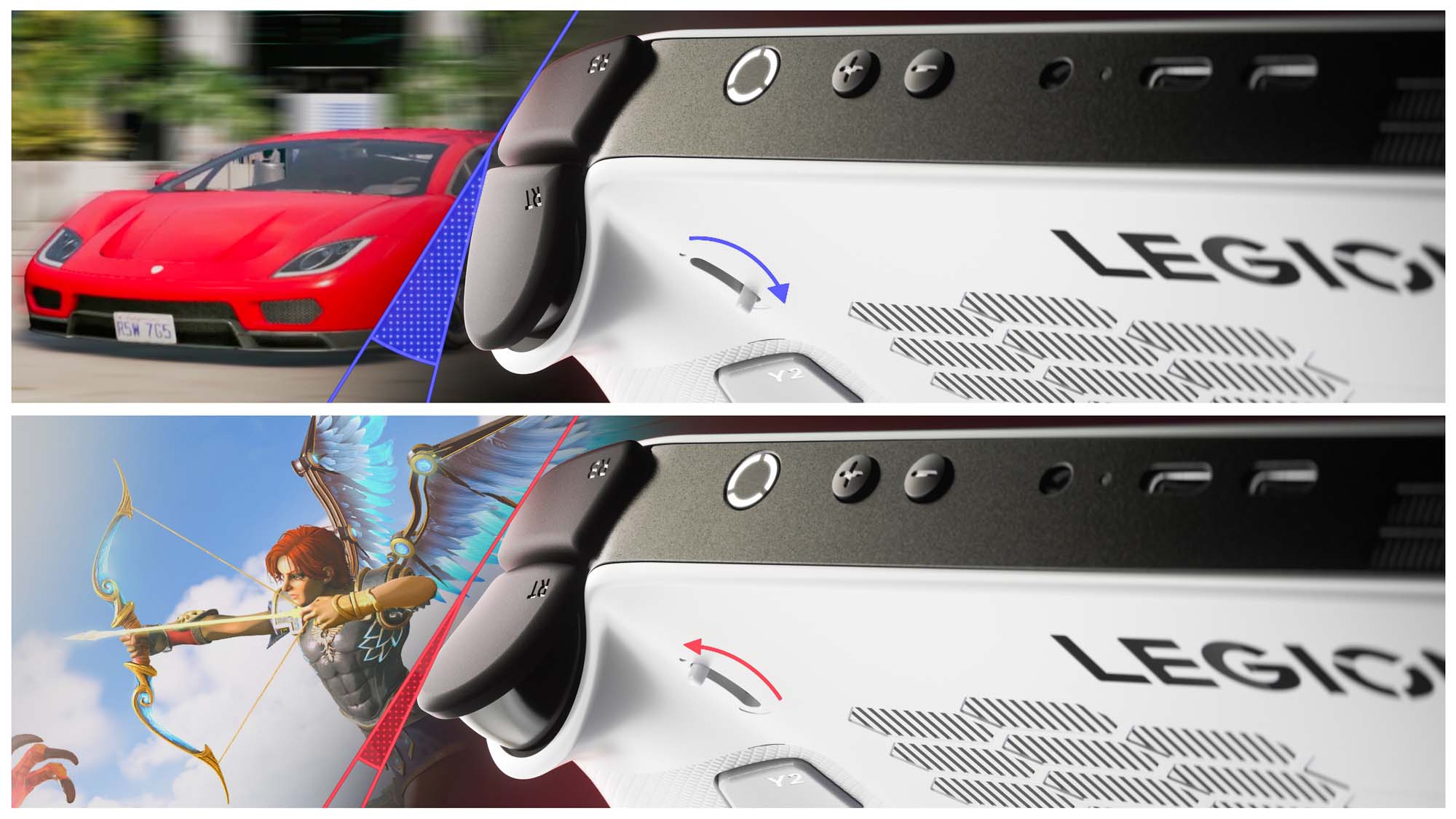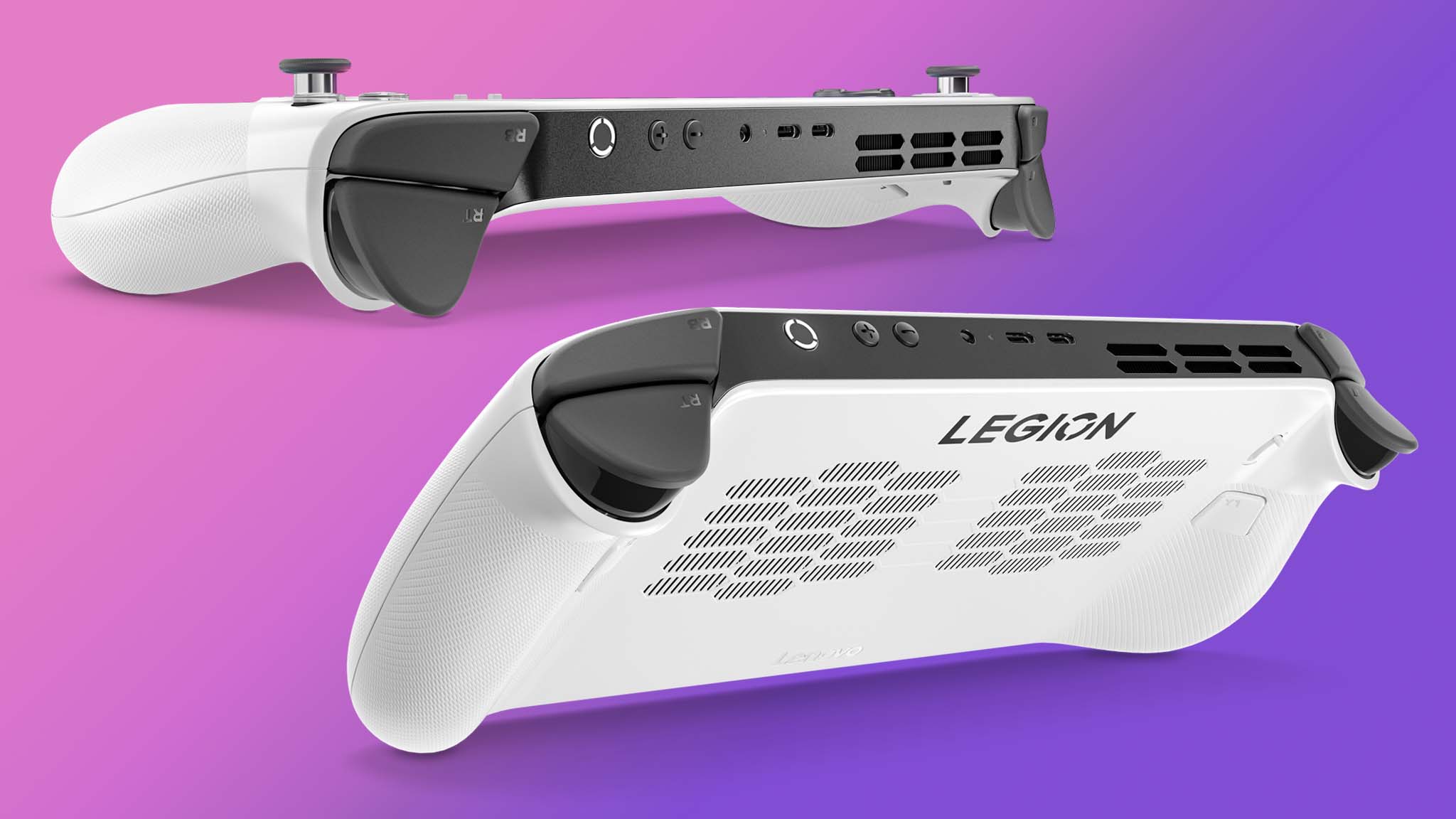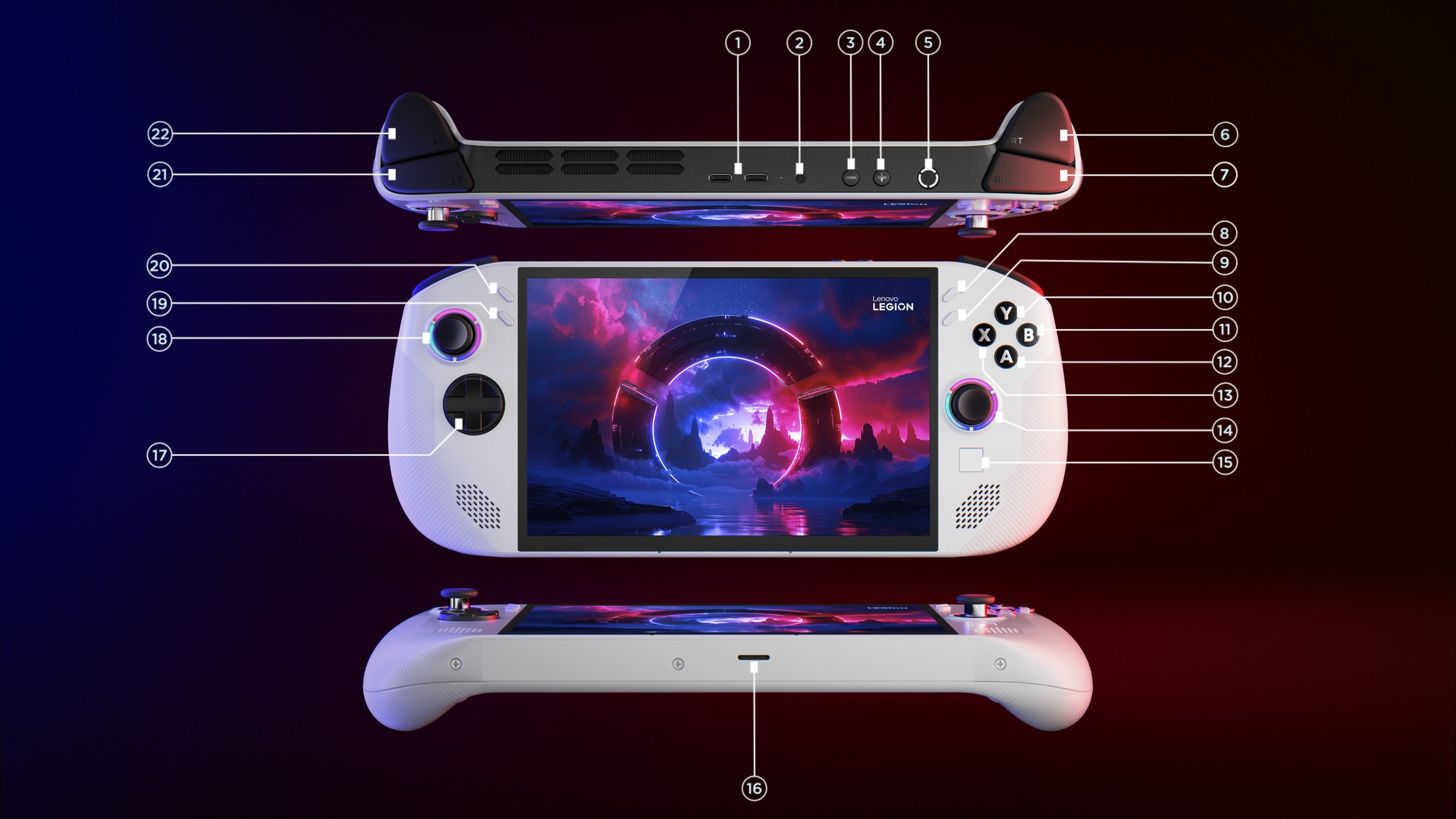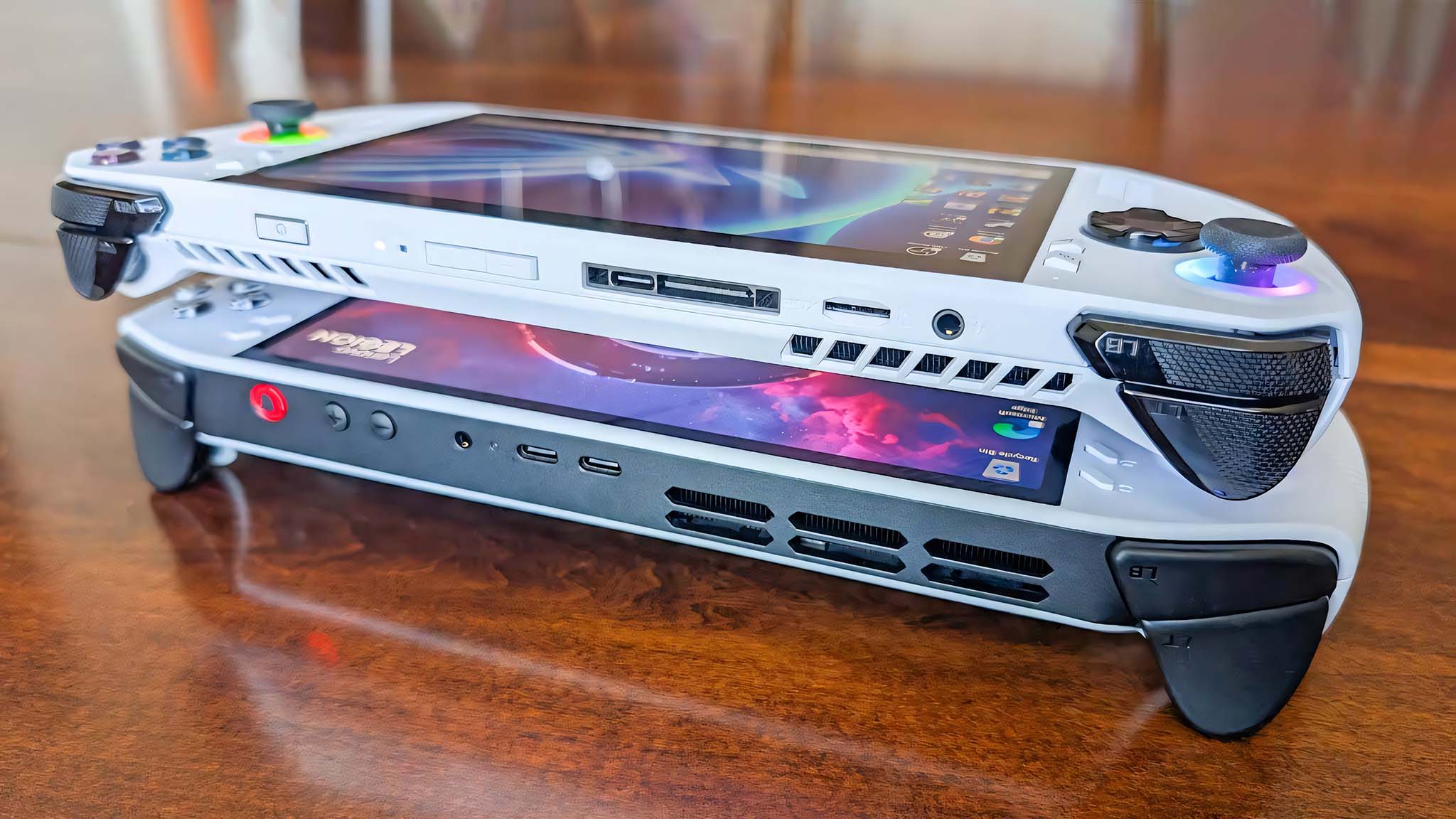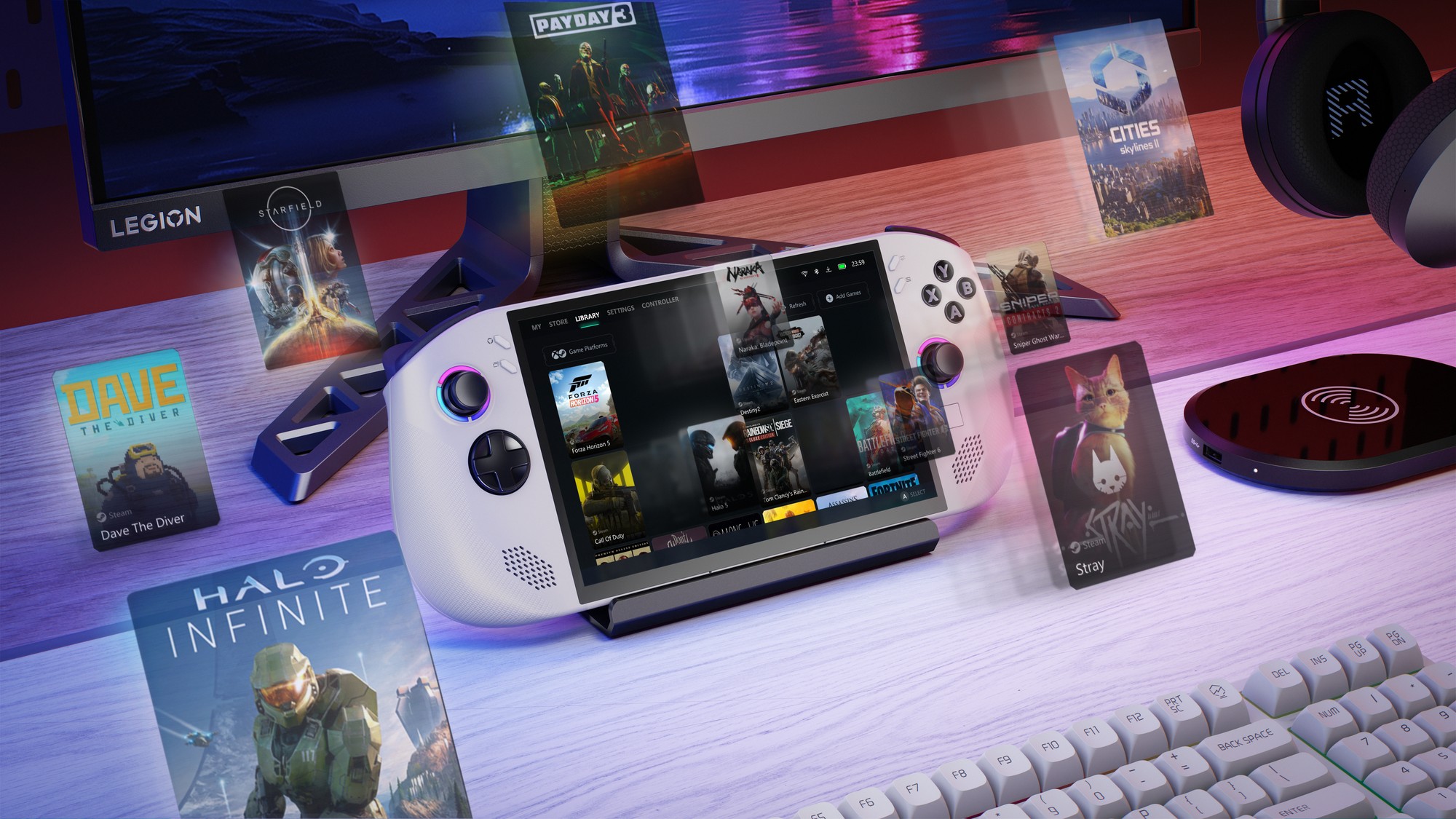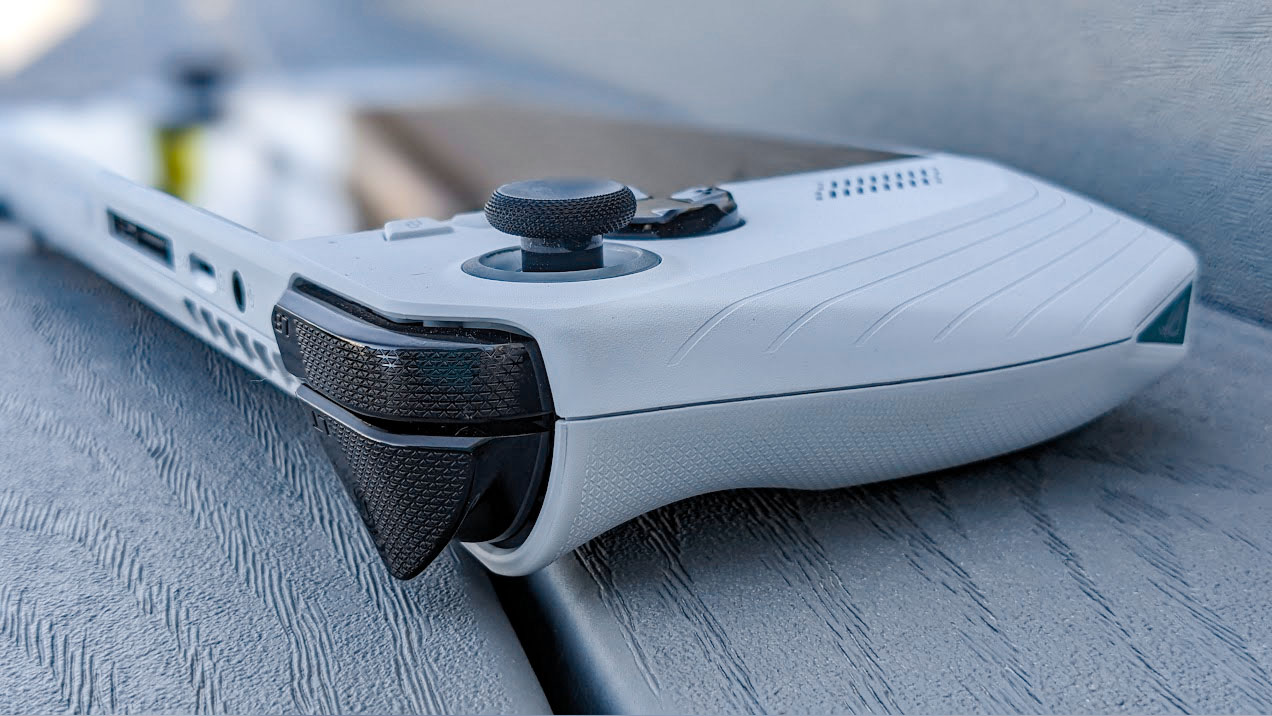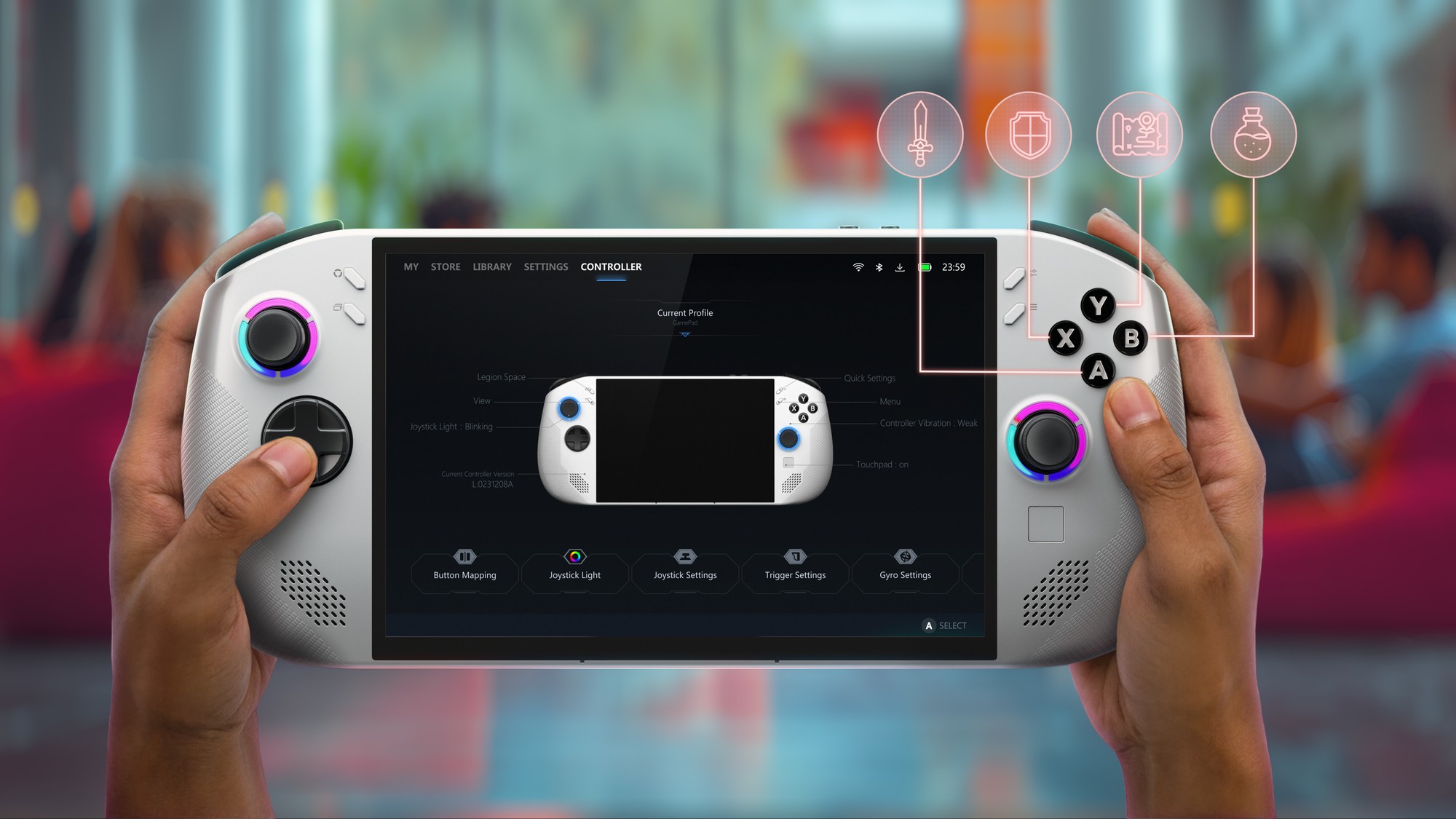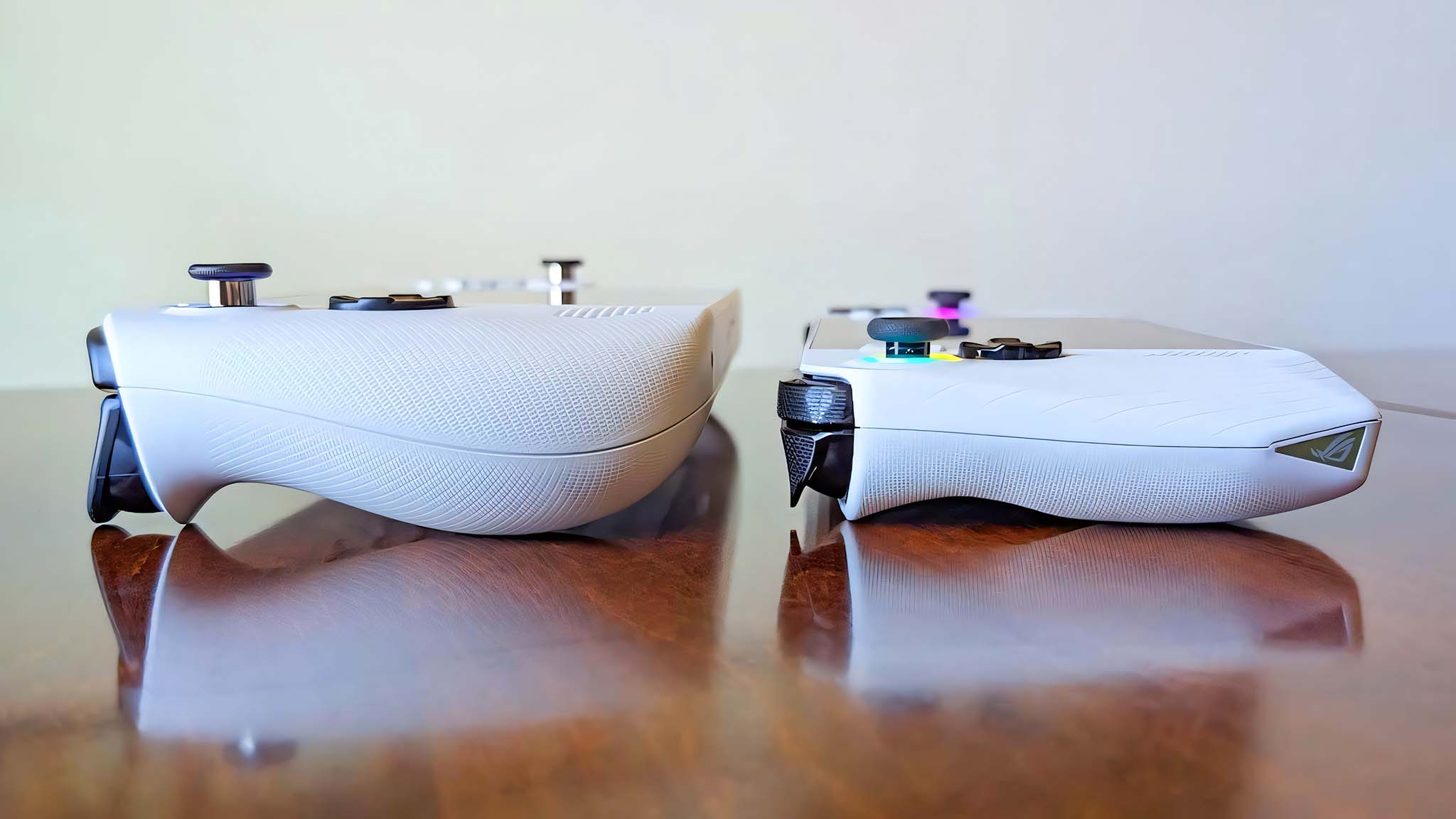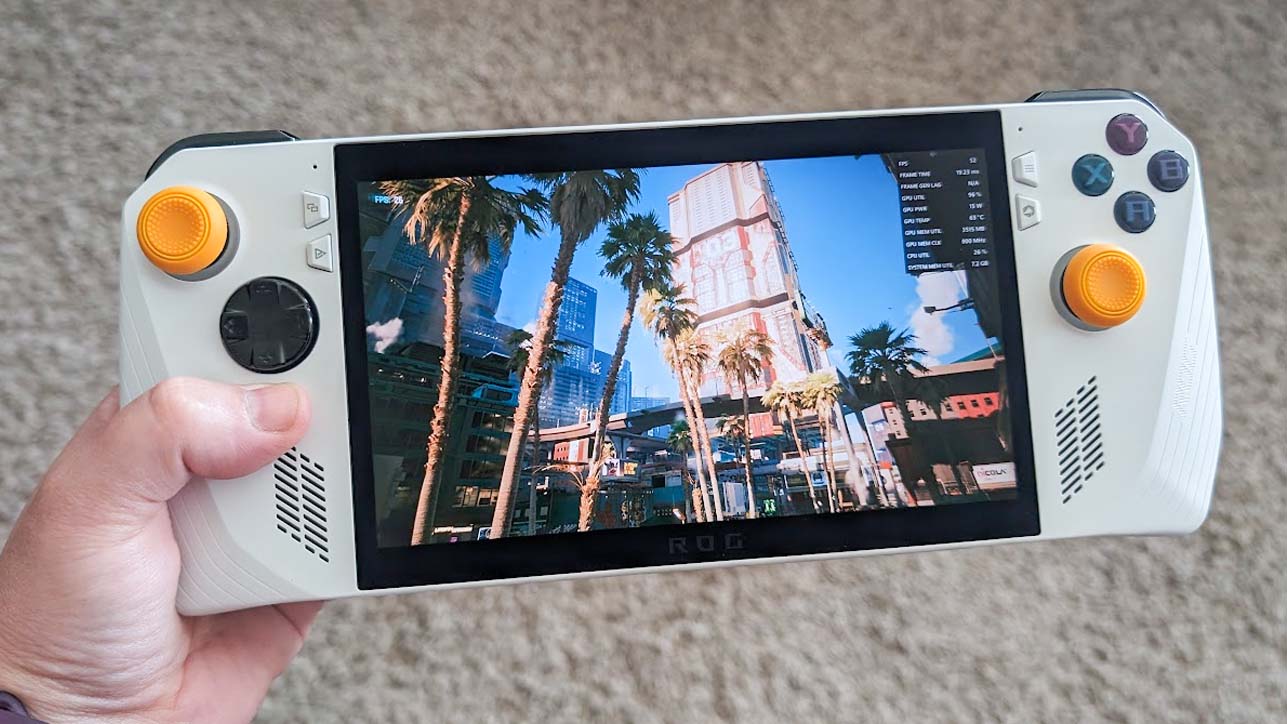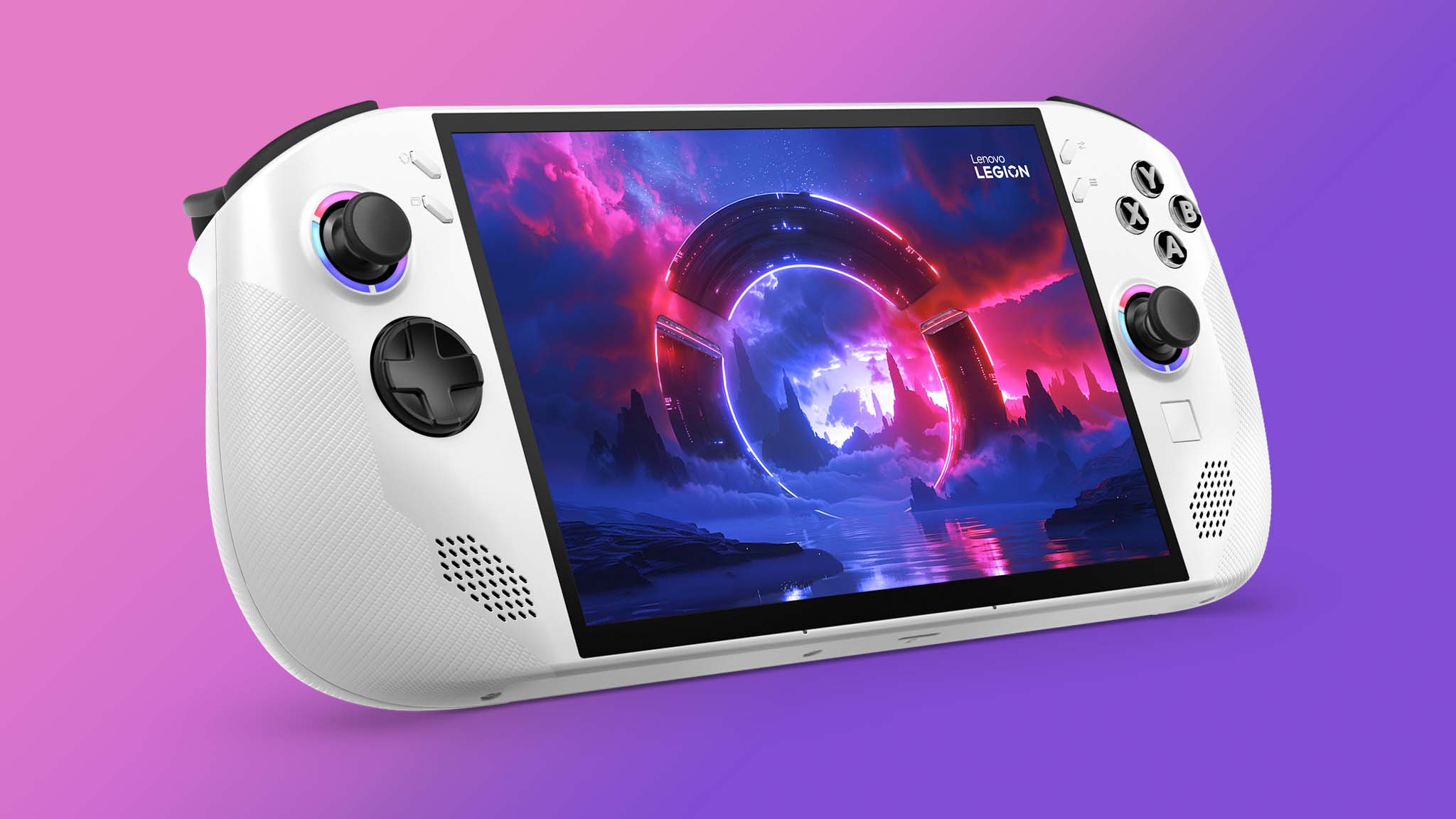Lenovo’s new gaming handheld will be available in both a SteamOS and a Windows 11 option. Depending on the configuration, it can come powered with a custom Z2 Go or a Z1 Extreme chip. It also comes with a whopping 32GB RAM and 1TB SSD. The touchscreen is somewhat large, measuring 8 inches. The display supports VRR, native landscape, and up to a 120Hz refresh rate. You can make use of accessories using the two USB4 ports.
The ROG Ally uses the first wave of AMD Ryzen Z1 or Z1 Extreme chips, which means it is a generation older than the new Legion Go S. Because of this, it costs less than Lenovo’s handheld while still offering a decent 7-inch IPS touchscreen that supports VRR and offers up to a 120Hz refresh rate. The device also comes with 16GB RAM and 512GB SSD. It might not have all the conveniences of newer handhelds, but it’s still a solid gaming device.
For
- Costs less than Legion Go S and frequently gets massive discounts
- Has a fingerprint reader
- Plenty of accessories on the market
- Offers good handheld performance
Against
- No SteamOS options
- Doesn’t have Thunderbolt ports nor a touchpad
- Smaller screen, RAM, and SSD
The original white ASUS ROG Ally, which launched in 2023, was the first major gaming handheld to run Windows 11. I was the one who conducted testing and wrote up our ROG Ally review for Windows Central. Since then, multiple competitors have come out of the woodwork, including the Legion Go line.
Now, with the new Legion Go S on the market, I decided I wanted to see how Lenovo’s new device compares to ROG Ally. In case you don’t know, there are two versions of the Legion Go S — the white Legion Go S (8″ , 1), which runs Windows 11, and the Nebula Violet (dark purple) Legion Go S — Powered by SteamOS (8″ , 1) that runs (you guessed it) SteamOS. Here’s how the Legion Go S compares to the ROG Ally.
Legion Go S vs Legion Go: Specs
| Header Cell – Column 0 | Lenovo Legion Go S | ASUS ROG Ally |
|---|---|---|
| Price | $499.99 (SteamOS) | $599.99, $729.99 (Windows 11) | $499 | $649 |
| Release date | Jan 2025 | May 2025 (SteamOS & more configurations) | June 13, 2023 |
| OS | Windows 11 Home | SteamOS | Windows 11 Home |
| Display | 8-inch WQXGA (1920 x 1200) 16:10 LCD touchscreen, 500 nits, 97% DCI-P3 | 7-inch (1920 x 1080) 16:9 IPS LED touchscreen, 500nits, 73% DCI-P3 |
| Refresh rate / VRR | 120Hz / Yes | 120Hz/ Yes |
| Processor | AMD Ryzen Z2 Go or AMD Ryzen Z1 Extreme | Unknown | AMD Ryzen Z1 | Z1 Extreme |
| Graphics | Integrated AMD Radeon 700M Series | Unknown | AMD Radeon RDNA 3 Graphics |
| Memory | Up to 32GB 6400Mhz LPDDR5X | 16GB 7500Mhz LPDDR5X |
| Storage | Up to 1TB PCIe SSD (Gen 4) | 512GB |
| Connectivity | Wi-Fi 6E and Bluetooth 5.3 | Wi-Fi 6E and Bluetooth 5.2 |
| Ports | 2x USB4, 1x microSD card reader, 1x audio jack | 1x USB-C 3.2 Gen 2, 1x ROG XG Mobile Interface, 1x microSD card reader, 1x audio jack |
| Touchpad | Yes (one) | No |
| Detachable controllers | No | No |
| Color | White or Nebula Violet (dark purple) | White |
| Dimensions (controllers attached) | 299 x 127.55 x 22.6mm (11.77 x 5.02 x 0.89in) | 280 x 111 x 21.2mm (11.02 x 4.37 x 0.83in) |
| Weight | 740g (1.63 lbs) | 608g (1.34 lbs) |
| Battery | 55.5 Whr | 40 Whr |
Now that you’ve had a chance to look over the comparison chart, lets go over these different point and explain more thoroughly how they impact the user experience.
Legion Go S vs ROG Ally: Price & value
As I previously explained, the Lenovo Legion Go S is coming in both a Windows 11 version that sells for $729.99 and then later a $499.99 SteamOS version. Meanwhile, the ROG Ally only has Windows 11 as an operating system. Of course, there’s also the larger Legion Go, which has a starting price of $699.99 at Best Buy.
There are two Ally options: An Ally with an AMD Ryzen Z1 processor that sells for $499.99 and a beefier Z1 Extreme Ally that sells for $649.99. It’s also worth noting that the improved ROG Ally X has a starting price of $799.99 at Best Buy and features a Z1 Extreme, 24GB RAM, and 1TB SSD.
However, you should note that the ROG Ally has regularly gotten discounted (I’ve seen it up to $200 off at Best Buy) during special sales events like Black Friday and Prime Day, whereas the Legion Go gaming handhelds haven’t seen as good of discounts. So, if you happen to buy a device during a sale period, you’re more likely to get a better deal for ROG Ally.
Obviously, the SteamOS Legion Go S is the least expensive. so it might be the best option for anyone on a budget. However, between the Windows 11 Ally and Go S devices, the ROG Ally Z1 is the less expensive handheld. That said, I’d recommend going with the $649.99 ROG Ally Z1 Extreme over the plain Z1; even though it costs more, it’s still cheaper than the Legion Go S. Because of this, I’d consider the ROG Ally the best value buy in this instance.
To be clear, the Legion Go S Windows handheld costs more because it does offer better features. It has a larger screen, dual Thunderbolt ports, more RAM, higher capacity SSD storage, and a larger battery than ROG Ally. So if you want the best of the best, Legion Go S might be what you’re looking for.
TL;DR: PRICE WINNER: There’s no denying that the Legion Go S (SteamOS) costs much less than the ROG Ally. However, if you’re looking for the most value for your buck then the ROG Ally Z1 Extreme is the best pick.
Legion Go S vs ROG Ally: Performance
In case you don’t know, the AMD Z2 Go chip offered with Legion Go S is custom silicon only available in Lenovo devices. In other words, we won’t ever see it in another handheld.
We’re still waiting to analyze the new AMD Z2 Go chip and see how it compares against the Z1 and Z1 Extreme chips. What we do know is that the Z2 Go offers better power consumption than the Z1 Extreme but isn’t as powerful as it. In other words, the battery might last longer with the Z2 Go, but intensive games might not run as smoothly with it.
Another thing to note is that the Go S offers 32GB RAM and 1TB SSD, while the ROG Ally only has 16GB RAM and 512GB SSD. Having more memory and storage space helps games run more smoothly, but we won’t know for sure how exactly these differences match up until we can compare the Go S and Ally ourselves.
Based on an educated guess, if you want a gaming handheld that offers better internals and can handle more graphically demanding games, then you’ll want to go with one that has a Z1 Extreme processor. Of the two handhelds, that leaves us with the more expensive ROG Ally since the only Legion Go S currently on the market does have the Z2 Go. However, it’s been hinted that more Go S configurations might come to the market over time, so this could change.
TL;DR: PERFORMANCE WINNER: It’s very likely that the ROG Ally Z1 Extreme offers better performance than the Z2 Go Legion Go S. However, the Legion Go S might have better battery life. We’ll know more after testing has been done on these devices.
Legion Go S vs ROG Ally: Display
Both Legion Go S models have an 8-inch, LCD, 16:10, touchscreen that can reach up to a resolution of 1920 x 1200, a brightness of 500 nits, and a refresh rate of 120Hz. Lenovo also claims that the display produces a very nice color gamut of 97% of DCI-P3, but we’ll have to test all of this to know for sure. The computer manufacturer also learned from its previous gen’s mistakes and has made sure that the Legion Go S display supports both VRR and native landscape. These are all very nice features
Meanwhile, the ROG Ally has a smaller 7-inch, IPS LED, 16:9, touchscreen that can reach up to 1920 x 1080, the same 500 nits of brightness, and the same 120Hz refresh rate. In my own colorimeter testing, the Ally’s screen produced a much lower 73% of P3, but it still looks good in person. Of course, the ROG Ally also supports VRR and native landscape, which helps the device produce better motion clarity in gaming.
TL;DR: DISPLAY WINNER: The Legion Go S not only has the larger display that supports VRR and native landscape, but it also looks like it has a better color gamut as well.
Legion Go S vs ROG Ally: Controls and ports
When you put the ROG Ally and the Legion Go S (Windows) side-by-side, the devices look relatively similar, with many of the buttons, bumpers, triggers, and controls in the same places. However, there are some key differences that make it obvious that the Go S has a better design than the Ally.
For one, the Legion Go S offers Hall Effect joysticks, which should never suffer from drift. This is something that is lacking in the ROG Ally. Although, there haven’t been that many reports of drift in the ASUS handheld.
Additionally, the Legion Go S has a small touchpad on the right side under the joystick, whereas the Ally does not. Lastly, the Go S has adjustable trigger switches on the back to give more custom control. The one thing that ROG Ally has that the Go S doesn’t is a fingerprint reader. It doesn’t always work correctly, but it can be very nice to have when it does. In case you’re wondering, the Legion Go 2 prototype does have a fingerprint reader.
While I’m talking about the Legion Go 2, the Go S does not have the larger device’s detachable controllers, nor does it have a kickstand. These are features in common with the Ally. If you’re interested, you can learn more about these handheld differences in our Legion Go 2 vs Legion Go S comparison.
It’s also worth noting that the SteamOS version of the Go S will have a specific Steam button, whereas the Windows 11 version has a Legion Space button.
The Go S also outshines the original ROG Ally when it comes to ports. ASUS only included one USB-C 3.2 Gen 2 port that also works as a combo port for the company’s ROG XG Mobile eGPU accessory. Meanwhile, Go S offers two USB4 ports, which makes it easy to charge the device with one port and plug in a different accessory with the other.
TL;DR: CONTROLS & PORTS WINNER: Since the Legion Go S offers Hall Effect joysticks, a touchpad, adjustable trigger switches, and two USB4 type-C ports, it has the better layout between the two handhelds.
Legion Go S vs ROG Ally: Software and games
Like the Steam Deck, the SteamOS version of the Go S is built to access your Steam library in a way that’s more reminiscent of a simplified console interface. However, that means that it isn’t set up to access other PC gaming services out of the box. You can definitely make adjustments to the Linux-based operating system so that you can play games on Xbox Game Pass, Battle.net, Epic Games, and more, but it will take some work to make that happen.
Meanwhile, the Windows Go S model and the ROG Ally both run Windows 11 and act just like a laptop (sans keyboard). This means you can do a lot with these devices, such as using a browser to navigate to other gaming services, downloading launchers, or accessing game files. The thing is, you might also have to deal with Windows 11 troubleshooting, which some find offputting on handhelds. Of course, we at Windows Central have a bunch of Windows 11 guides if you need any assistance with any of that.
The Ally comes with Armoury Crate installed, while the Go S comes with Legion Space. These applications let you adjust system settings while also serving as game launchers and stores. There are pros and cons to both software, but at the moment, Armoury Crate offers better customization options, including the ability to adjust VRAM. Weirdly enough, you have to go into the Go S BIOS in order to change VRAM, which isn’t ideal.
Since both devices use AMD chips, it’s also in your best interest to use AMD Software on the Windows handhelds, a program that gives additional control over either system. This is where you’ll go to enable things like AMD Fluid Motion Frames 2 (AFMF 2), Anti-lag, and other performance-boosting features.
TL;DR: SOFTWARE & GAMES WINNER: You could argue that Legion Go S offers better options to choose from since it will have both a SteamOS and Windows version. However, ROG Ally’s Armoury Crate provides better settings and customization options. So, between the two Windows devices, ROG Ally is better.
Legion Go S vs ROG Ally: Battery life
Gaming handhelds are pretty notorious when it comes to battery life.; It’s one of the worst areas of these devices. As it is, the first-gen Windows 11 gaming handhelds, like ROG Ally, typically don’t last more than an hour at max TPD when playing graphically demanding games. That’s not ideal.
It’s very likely that Go S will last longer than Ally due to it having a larger 55.5 Whr battery compared to Ally’s 40 Whr battery. Plus, the custom Z2 Go chip in the Go S is supposed to offer better power consumption than the Ally’s Z1 Extreme.
TL;DR: BATTERY LIFE WINNER: This is hard to know for sure until we conduct testing. However, it is very likely that the Legion Go S will have better battery life than the Ally.
Legion Go S vs ROG Ally: Grip ergonomics and comfort
When you look at the ROG Ally and Legion Go S side-by-side, Lenovo’s device looks a lot more rounded. This is interesting, considering that the Ally looks a lot more rounded compared to the blocky, original Legion Go. Still, both devices offer really nice ergonomic designs that are even more comfortable to hold than you might think.
In terms of size and weight, the Go S is a slightly bigger device. It’s 11.77 inches wide, 5.02 inches tall, 0.89 inches deep, and weighs 1.61 pounds. Meanwhile, the Ally is 11.02 inches wide, 4.37 inches tall, 0.83 inches deep, and weighs in at 1.34 pounds.
The gripping area on the Legion Go S is more rounded and thicker, while the ROG Ally is more angular and has a slanted area in front to better make way for your palms. That said, the Ally’s large back buttons awkwardly edge into the gripping area, which makes this smaller handheld a bit less comfortable to hold than the Legion Go S. This was something that was adjusted for the ROG Ally X.
TL;DR: COMFORT WINNER: The Legion Go S has a great ergonomic shape to its casing, and the back buttons don’t get in the way of your grip like the Ally’s back buttons do.
Legion Go S vs ROG Ally: Comparison chart
| Category | Winner |
|---|---|
| Price | The Legion Go S (SteamOS) is the budget buy, but the ROG Ally Z1 Extreme is the value buy. |
| Performance | It’s very likely that the ROG Ally Z1 Extreme will offer better performance than the Legion Go S Z2 Go. |
| Display | There’s no denying that the larger 8.8-inch touchscreen on the Legion Go S is better. |
| Controls & ports | The Legion Go S has better controls thanks to it having Hall Effect joysticks, a touchpad, and adjustable trigger switches. |
| Software & games | Currently, it’s a lot easier to customize the ROG Ally through ASUS software application than it is on Legion Go S. |
| Battery life | The Legion Go S likely lasts longer due to having a larger battery and a more power-saving chip. |
| Grip | The Go S comes out on top here since it doesn’t have back buttons that get in the way of your grip. |
| Best overall | All in all, the Legion Go S offers several improved features over the Ally, but it is expensive. Meanwhile, the Ally is likely a better value and might offer better performance. |
Legion Go S vs ROG Ally: Which should I buy?
In the end, there are some major tradeoffs between going with the Legion Go S or the ROG Ally. Either gaming handheld could be a great pick, depending on what you value most in your gaming device.
Our Top Gaming Recommendations
The Legion Go S (SteamOS) is the least expensive option and will offer the simplest interface. As such, it’s ideal for anyone on a budget or who wants a handheld that operates similarly to a console.
That said, if you’re more interested in getting a handheld that offers better performance, then the ROG Ally Z1 Extreme is your best bet. It might not have the best battery life, but it can play many of the latest AAA games relatively smoothly. Of course, if you play plugged in or with the handheld connected to a docking station then you won’t have to worry about battery life.
Lastly, if you don’t tend to play a lot of graphically intensive games and want a device that can last a long time then the Legion Go S (Windows) is probably the device for you. It specifically uses a custom chip that is supposed to offer far better power consumption than the Ally’s chip. Additionally, it has a higher battery capacity than ASUS’s device.
This new device is ideal for people who simply want a handheld gaming system. Depending on the configuration you go with, it can run SteamOS or Windows 11. It can have up to a Z2 Series chip, up to 32GB RAM, and up to 1TB SSD to meet your gaming needs.


